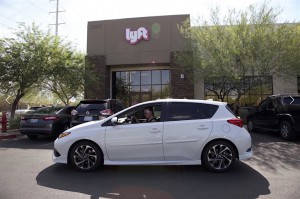
A new study shows that Lyft and Uber vehicle owners have terrible records when its to getting recall repairs completed.
Less than a week ago, the world discovered that Uber, Lyft and other ride-hailing service vehicles are the dirtiest ways to get someone to drive you somewhere. Now it may also be that they are the least safe, according to a new study.
Consumer Reports claims that one out of six Uber and Lyft drivers in the New York City and Seattle areas are driving vehicles with outstanding recalls. However, unlike the search for a more sanitary ride, taxis may not be a better option.
The magazine says that nearly a quarter of all for-hire vehicles in the Big Apple also need to have their vehicles brought in to address a recall of some sort. Recalls can range from something as simple as a faulty light or sensor to – as we’ve seen recently – more dangerous problems such faulty airbags, engine fires and seat-belt problems.
“Uber and Lyft are letting down their customers and jeopardizing their trust,” said William Wallace, a CR safety policy advocate.
(All grossed out and nowhere to hide: ride-hailing cars the nastiest. Click Here for the story.)
“Uber’s website says people can ‘ride with confidence,’ while Lyft promises ‘peace of mind,’ yet both companies fail to ensure that rideshare cars are free from safety defects that could put passengers at risk.”

Uber and Lyft vehicles are not only the dirtiest way to get a ride, but now may be unsafe in some instances.
Consumer Reports examined the safety records for about 94,000 vehicles registered as operating for the companies in New York City and King County, Washington, which covers Seattle and several suburbs. They were selected because the local governments require drivers to register vehicles and obtain an additional license to work through regulators, the magazine noted.
Uber and Lyft said they’re working on the problem. Uber officials told Consumer Reports the company reminds drivers to get recalls fixed. It also blocks vehicles on its platform that have some of the most dangerous open recalls, ones with “DO NOT DRIVE” warnings from the manufacturer or the National Highway Traffic Safety Administration.
(Click Here for details about Lyft’s IPO depending on an autonomous future.)
The sub-par effort by ride-hailing drivers to ensure their vehicles are safe shouldn’t be all that surprising. These are their personal vehicles being used to cart folks around towns. And the percentages discovered by the magazine are basically in line with the results of most recalls.
“Lyft drivers use their personal vehicles to drive on the platform—the same car they use in their daily lives, driving their kids to school or friends around town,” Lyft told the magazine in a statement. “Drivers have a strong personal incentive to make sure their car is in a safe operating condition.”
Vehicles that are 6 to 10 years old at the time of the recall average a 56% completion rate, compared to 76% for vehicles that are 1 to 5 years old, and 80% for vehicles under 3 years old, according to NHTSA.
(Ride-hailing services don’t cut traffic, they add to it. Click Here for the story.)
Last year, there were 722 recalls affecting more than 29 million vehicles in the United States. In 2017, there were 900 recalls affecting over 42 million vehicles.
